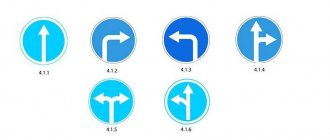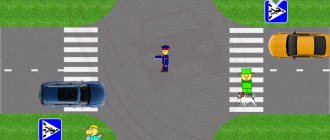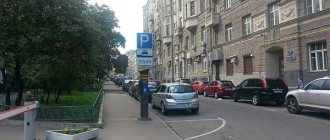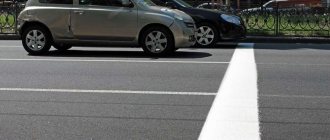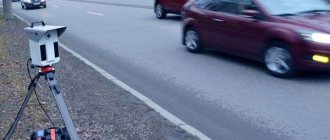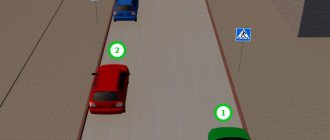What is a reversal
According to the interpretation specified in the traffic rules, a turn is a maneuver, as a result of which the car completely changes the direction of its movement. Moreover, this maneuver can be performed both at the intersection and outside it. A prerequisite for turning around must be good visibility of the road in both directions. In addition, the vehicle making the U-turn must also be within sight of other road users.
Where U-turn is prohibited
In accordance with paragraph 8.11 of the traffic rules, a ban on the right to turn a car is provided for the following areas:
- At pedestrian crossings;
- On bridges and tunnels;
- On overpasses, overpasses, and also under them;
- At railway crossings;
- Where in any direction of movement the roadway is visible for no more than 100 meters;
- At public transport stops.
These places where U-turns are prohibited are by no means random. Making a U-turn on such road sections poses a serious danger both to the driver and passengers of the vehicle making the U-turn, as well as to passengers of other vehicles, as well as road pedestrians.
Another important nuance: when turning, you should never cross the double solid marking line. If it is applied to the road surface, the driver must choose another place to turn around.
You also need to take into account that making a U-turn is strictly prohibited in those places where the “U-turn is prohibited” sign is installed.
Most often, this sign is installed by road services in front of those intersections where the movement of vehicles is difficult or such a maneuver may create a danger for other road users or pedestrians.
By the way, many motorists believe that the “No U-turn” sign also restricts other maneuvers. Actually this is not true. Turning left and driving in a straight line is not prohibited for the driver.
This sign can be installed not only on the right side of the road, but also on the left, as well as on the dividing strip. This is done so that the driver is more vigilant and does not make a U-turn in places where there is a danger for all road users.
In addition to installing a sign prohibiting a U-turn, an additional sign can be installed in conjunction with it, which determines at what distance a U-turn is prohibited.
Also, it is necessary to understand that this sign does not apply to public transport, since it may have a clearly defined route according to which it must move.
How to increase turning space
See also
DIY plastic bumper repair: video instructions
Surely most motorists know about the concept of the left extreme position. According to this term, the car should be moved as far as possible to the left on the roadway within the left lane. In fact, the driver presses against the solid line that separates oncoming traffic with the left side of his vehicle. This will be considered the extreme left position.
But let's assume that the road turned out to be fairly clear. There are no oncoming cars, and no one is trying to push on the starboard side. Then the turn does not have to be performed strictly through the left extreme position. There is no need to press against the double solid line here.
Instead, the maneuver can be started from the middle or from the right edge of the left lane.
Sometimes the large dimensions of the vehicle do not allow enough space to turn around safely outside the intersection.
The rules do not prohibit it, and therefore it is allowed to perform the action by occupying the right edge of the roadway. That is, starting to move from the right side of the road. This is stated in clause 8.8.
Of course, such actions should not contradict clause 8.11. That is, you need to yield before the maneuver not only to oncoming vehicles, but also to all passing cars.
If an accident occurs, the one who made the U-turn will be found guilty. After all, in fact, it is this motorist who will be violating the maneuvering rules.
And it also happens that there is no confidence in the legality of the maneuver. The driver is not 100% sure whether he is doing everything correctly. And this applies not only to reversals.
In this situation there are 2 ways out. The first is to take a risk and do it. The second option is more preferable based on security reasons. You need to refrain from the maneuver and find another place where you can perform it, without breaking any rules.
Where and how is a U-turn allowed?
The current version of the traffic rules states that U-turns are allowed both at intersections and free sections of the road outside intersections.
If there is no dividing strip on the roadway, you can make a U-turn in those places where there is no continuous marking line. On a road with several lanes in each direction, you need to find a special place to turn around. It is usually designated by 6.3.1 or 6.3.2. If these signs are not installed, the driver can navigate along the broken road marking line.
Dear reader! Didn't receive an answer to your question? Our expert lawyers work for you. It's absolutely free!
- Moscow ext 152
- St. Petersburg ext 152
- All regions ext 132 (Toll free)
As for the procedure for turning around at an intersection, this maneuver must be performed taking into account the requirements of Chapter 13 of the current edition of the traffic rules. It is she who reveals the order in which movement occurs at the intersection. It is important to understand that a U-turn at an intersection must be made only from the far left lane
In a situation where the turning maneuver must be performed not at an intersection, the driver must refer to rule 8.8. This clause specifies that a turn must be made from the extreme left lane, and if the road also contains tram tracks running in the middle of the road, then the turn must be made from the rails running in the same direction.
In addition, we must not forget that the driver of a vehicle making a U-turn must allow all oncoming vehicles to pass. If the turn is made through tram tracks, you will also need to pass passing and oncoming trams.
In some cases, the width of the roadway may not be sufficient to perform a classic U-turn from the leftmost lane. Thus, the vehicle will interfere with those cars that need to give way. For such situations, clause 8.8 provides an exception, thanks to which it is allowed to start a turn not from the extreme left position, but from the extreme right or from the right shoulder. In this case, the driver must give way to all passing and oncoming vehicles. The driver must wait for the appropriate moment and only then make a U-turn. Thus, no interference will be created for other traffic participants and the turn will be completed successfully.
A similar turning option is allowed for various long vehicles, the dimensions of which do not make it possible to make a turn from the leftmost lane.
But none of the traffic rules gives you the right to make a U-turn from the middle of the road. Therefore, when approaching an intersection, if it is necessary to make a U-turn, the driver of the car must take the extreme left position on the road. If the turn is not made at an intersection, then you need to take one of the two extreme positions on the roadway.
If the driver needs to make a U-turn when approaching a roundabout, then this maneuver is allowed only after the middle of the intersection has been detoured.
Rules for performing a turn
A U-turn can be performed in any place where it is not prohibited by rules, road signs or markings. The conditions under which a turn is prohibited will be discussed below.
However, when making a turn, you need to be very careful about choosing where to maneuver. In general, 2 options are possible:
- turning around at an intersection;
- U-turn outside the intersection.
U-turn at an intersection
The rules for turning around at an intersection are regulated by paragraph 8.5 of the traffic rules:
8.5. Before turning right, left or making a U-turn, the driver is obliged to take in advance the appropriate extreme position on the roadway intended for traffic in this direction, except in cases where a turn is made when entering an intersection where a roundabout is organized.
Thus, a turn at an intersection must be made from the extreme left position, i.e. from the center of the roadway.
Pay attention to this point. For example, it is impossible to make a U-turn at an intersection where two narrow two-lane roads intersect without violating traffic rules. In order not to drive onto the lawn or sidewalk, the driver will have to either violate the requirements of paragraph 8.5 (turn around from the extreme right position) or engage reverse at the intersection (violate paragraph 8.12 of the traffic rules).
U-turn outside the intersection
A U-turn outside an intersection is subject to different rules:
8.8. When turning left or making a U-turn outside an intersection, the driver of a trackless vehicle must give way to oncoming vehicles and a tram in the same direction.
If, when turning outside an intersection, the width of the roadway is not sufficient to perform the maneuver from the extreme left position, it is allowed to be made from the right edge of the roadway (from the right shoulder). In this case, the driver must give way to passing and oncoming vehicles.
Outside the intersection, a U-turn can be made both from the center of the roadway and from its right edge. You can also start turning from the right side of the road. The second option is certainly the most preferable. A passenger car that has started to turn from the side of the road, even on a two-lane road, will be able to complete the maneuver without engaging reverse gear. If it was not possible to fit in, then outside the intersection the rules do not prohibit turning into reverse.
In practice, it is usually more convenient to make a U-turn outside an intersection than at an intersection.
What signs prohibit turning a car?
The main sign that prohibits a U-turn maneuver is the “No U-turn” sign. It consists of a black arrow crossed out with a red stripe on a white background with a red border. The “No U-Turn” sign itself is round in shape.
Most often, this sign is installed at intersections and prohibits a U-turn maneuver at this particular intersection. At all subsequent intersections, it is possible to make a U-turn if a prohibition sign is not installed in front of them.
In addition to the above sign, there is a whole series of them prohibiting making a U-turn in a certain area of traffic. Thus, the list of road signs that do not provide for the ability to make a U-turn includes:
- Those that indicate the presence of a pedestrian crossing;
- Notifying about approaching the entrance to the tunnel;
- Indicating a railway crossing located ahead;
- Those that notify that there is poor visibility on the road ahead;
- Informing about the location of vehicle stops;
- Signs that indicate continuous single or double markings applied.
But there are no separate special signs that would allow a U-turn on a certain section of the road. There are other signs indicating permissible directions of movement, but the “Turning is allowed” sign is not in the traffic rules.
U-turn without intersection
You might have the impression that we will only talk about U-turns at intersections. But that's not true. After all, turning around outside an intersection is also performed by drivers very often and it is an important part of everyday road traffic.
If the markings allow you to make a U-turn on the road, that is, it changes from solid to intermittent on one or both sides, then, taking the extreme left position, begin the maneuver, accordingly allowing oncoming traffic to pass. There is a nuance here: you can make a U-turn on a multi-lane road using this pattern without any particular difficulties; the space allows you to build a trajectory without the need to rest against the curb and back up, which would be inconvenient and very dangerous on a busy road. A turn on a narrow road, as the rules say, can, if necessary, be made not only from the left lane. In this case, take the lane to the right, let the passing traffic pass along with the oncoming one, and then start driving. If there is no right lane (for example, this happens on a narrow country road), then using the shoulder is allowed. It is the curb, not the sidewalk, that is very important. But be careful and attentive, be sure to signal drivers about your intention with your turn signals, because you need to let two traffic pass at once.
If there are tram tracks at the place where you turn outside the intersection, then (in the absence of prohibitory signs and markings, of course) you should make a turn on the road from them. In this case, you miss two streams and a tram.
The main thing about this maneuver is that it should be performed only when you do not create obstacles for other road users. Turning on a four-lane road will not create any difficulties for you: it is wide enough, and you can easily occupy the lane needed for this. Turning around on a two-lane road will be somewhat more difficult, but also quite doable. But we’ll tell you right now when you can’t turn around at all.
